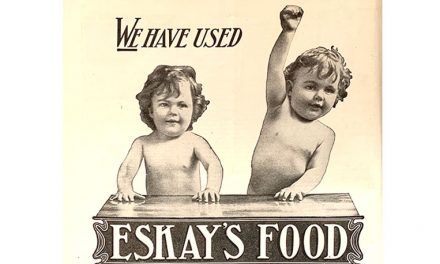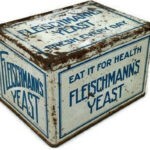A little booklet of the adventures of
the Microbe Family, written in what Dupont called “merry verses,” promoted greater acceptance of Cellophane
Just one of those merry verses was published in this 1935 full-page, full-colour advertisement on the costly inside back cover of The Canadian magazine.
Three little drops of moisture lived
Within some cigarettes,
Kept their tobacco-cottage fresh –
The precious little pets
One night they hung their panties up
And snuggled into bed,
When at the window there appeared
A most horrific head
It was the thirsty Dryness Bug
A‑glowering at the pane,
“You can’t come in”, the kiddies cried,
“We’re safe in Cellophane!”
Cellophane revolutionized packaging. It was used to wrap and protect the freshness of countless products. It was the most popular material for manufacturing cigar and cigarette packaging; its permeability to moisture made cellophane the perfect product for this application as cigars and cigarettes must be allowed to “breathe” while in storage.
A couple of questions: were these merry verses directed to adults or to kids and why would Dupont advertise an industrial product in a consumer magazine.
Dupont advertised this industrial product in consumer magazines to promote consumer acceptance of their industrial product thereby increasing the attractiveness of Cellophane to the manufacturers of consumer products.
The Cellophane brand was so famous that it became the generic term for see-through plastic wrapping.


The Canadian was Canada’s oldest magazine. It was founded in 1823, when Canada was still the Dominion of Canada. Throughout most of the 116 years of the Canadian’s existence it played no small part in the upbuilding of a national Canadian spirit.
In 1926, the Canadian was acquired by Hugh C. MacLean Publications Limited, and its circulation rose from 9,600 paid subscriptions to more than 137,000 in 1938. In November, 1937, the property was taken over by a newly organized company which put additional capital into it. But publication ceased in 1939. The publishers blamed the Government of Canada for refusing to put Canadian magazines on an equal basis with their United States competitors.
A statement published in the farewell issue of the Canadian read: “Since 1926 Canadian Magazine has paid out to the Dominion Government $135,000 in postage alone. Millions of copies of foreign periodicals are carried in Canadian mails without paying Canadian postage. Although foreign periodicals enter Canada absolutely free of duties or taxes, the cost of materials and advertising in Canadian magazines is increased by duties and taxes not imposed upon their foreign competitors. Almost everything that the Canadian publishers require is taxed. Foreign competitors contribute nothing in duties or taxes.”











